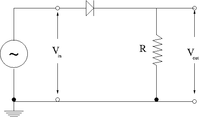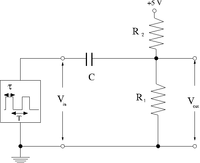Difference between revisions of "Lab 9 TF EIM"
Jump to navigation
Jump to search
| Line 5: | Line 5: | ||
[[File:TF_EIM_Lab9.png | 200 px]] | [[File:TF_EIM_Lab9.png | 200 px]] | ||
| + | |||
| + | Use a transformer for the experiment. | ||
| + | |||
| + | here is a description of the transformer. | ||
| + | |||
| + | [[File:TF_EIM_241_transformer.pdf]] | ||
2.) Use a sine wave generator to drive the circuit so <math>V_{in} = V_0 \cos(2 \pi \nu t)</math> where <math>V_0 = 0.1</math> V and <math> \nu</math> = 1kHz. (20 pnts) | 2.) Use a sine wave generator to drive the circuit so <math>V_{in} = V_0 \cos(2 \pi \nu t)</math> where <math>V_0 = 0.1</math> V and <math> \nu</math> = 1kHz. (20 pnts) | ||
Revision as of 00:24, 23 February 2011
Lab 9: Diode Circuits
Clipping Circuit
1.) Construct the circuit shown below using a silicon diode.
Use a transformer for the experiment.
here is a description of the transformer.
File:TF EIM 241 transformer.pdf
2.) Use a sine wave generator to drive the circuit so where V and = 1kHz. (20 pnts)
3.)Based on your observations using a oscilloscope, sketch the voltages and as a function of time.
4.)Do another sketch for = 1.0 V and another for 10.0 V (DONT LET ANY SMOKE OUT!). (20 pnts)
Differentiating Circuit with clipping
- Construct the circuit below.
- Select and such that the current from the +5V DC source is less than 1.0 mA and the DC voltage at is 3 V when there is no input pulse.
- Select a capacitor and a pulse width \ to form a differentiating circuit for the pulse from the signal generator. Hint: .
- plot and as a function of time using your scope observations. (20 pnts)
- Now add the diode circuit from part 1 to prevent from rising above +5 V. Sketch the new circuit below.
- plot and as a function of time with the diode circuit you added using your scope observations. (the diode should clip off positive spikes)(20 pnts)
Questions
- Explain your results in parts 1 & 2 in terms of the diode turn-on voltage. (20 pnts)

